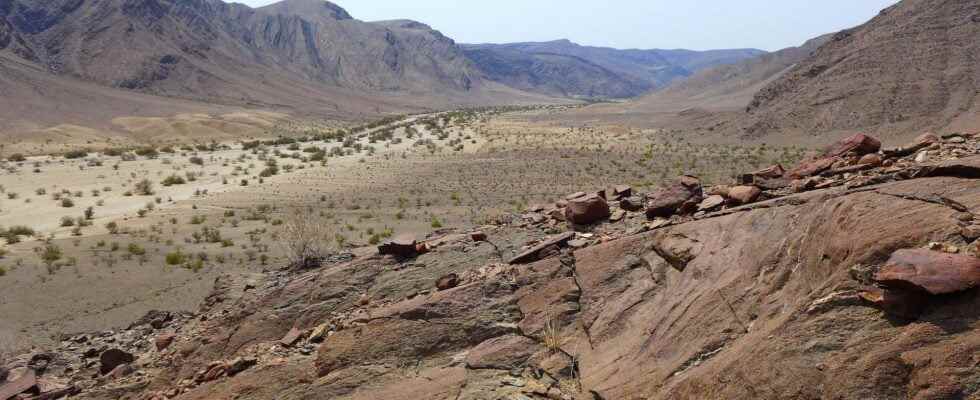If the word “fjord” immediately makes us think of Norway, a team of geologists has just found traces of these great valleys carved by glaciers in a completely different region of the world: Namibia. These paleo-fjords allow us to learn more about the penultimate glaciation that the Earth experienced, but also on the role that fjords play in the carbon cycle and in climate regulation.
You will also be interested
[EN VIDÉO] Evolution of the Earth’s ice mass between 2003 and 2010 The masses of the Globe’s glaciers and ice caps (in yellow) were measured over eight years as part of the Grace program. The colors blue and red are respectively used to quantify the loss or gain of ice. © NASA
The fjords are generally characterized by narrow valleys with high cliffs incising the coast, invaded by the sea. They mark the coastal landscape of the countries located in the highlands. latitudes, like Norway, testifying to the last ice age experienced by Earth. These great valleys are the result of the work ofabrasion glaciers in the continental base. They therefore represent valuable sites for understanding the dynamics of glaciers during major ice ages. But that’s not all. The fjords are also centers of very important sedimentary deposits. Therefore, they play a major role for the organic carbon storage and therefore have the ability to influence the climate. Their study is therefore essential to understand the evolution of the Earth’s climate over geological time. However, there are few examples of fjords dating from the pre-Cenozoic era, which would allow us to study glaciations prior to the last glaciation of the Quaternary having shaped the Norwegian fjords. The rarity of paleo-fjords should be associated with their morphology, which makes them particularly prone to erosion.
Traces of ancient fjords in Namibia
However, a team of researchers led by Pierre Dietrich of the University of Rennes discovered a whole network of paleo-fjords on the northwest coast of Namibia. These fjords were formed during the penultimate glacial episode dating from the end of the Paleozoic. This period lasted from -360 to -260 million years ago, making it a particularly long glaciation in Earth’s history. At that time, Namibia was part of the supercontinent Gondwana. “This is the first example of fjords fossils fully preserved “, explains Pierre Dietrich. “The desert landscape of northern Namibia is actually a glacial paleo-landscape! “
The network of paleo-fjords of Namibia is characterized today by valleys incising a series of plateaus. These valleys, now occupied by rivers, are 1 to 5 kilometers wide and 80 to 130 kilometers long. Their glacial past is not in doubt for the geologists : their bottom as well as their sides are marked by the traces of the passage of the old glaciers. Streaks and scratches, as well as various marks of friction and abrasion of the ice, mark the rocks of the basement. These traces make it possible to establish the direction of flow of the former ice mass. The researchers also found sediment glaciogenic dating from around 300 million years ago, composed of numerous rocky debris. Thanks to these witnesses of glaciation as well as to the post-glacial sediments surmounting them, the geologists were able to reconstruct the dynamics of the ice cover of the time.
Ice cover almost two kilometers thick
The depth of the incisions, with fjords reaching up to 1.7 kilometers in depth, as well as the presence of numerous and imposing erratic boulders, imply the presence of an ice cover completely covering the valleys during the first phase of glaciation. The ice thickness would thus have exceeded 1.7 kilometers. Ice flowing in these valleys would have been fed by a large ice cap located further east. This phase of maxima was followed by a decrease in the thickness of the ice. It is not excluded that this ice age was marked by several cycles of maxima-minima, to end with the melting total ice and sea invasion in the fjords. “Fjords also have a very strong control on the stability of the caps because they drain the ice from the caps to areas where the ice melts and disintegrates. The more ice that flows, the more the fjords widen under the effect of erosion, which increases the effect of drainage fjords. Over time, the caps thus become more and more sensitive to climatic variations ”, adds Pierre Dietrich.
The study of the paleo-fjords of Namibia also provides a better understanding of the climate change radical that took place between the glaciation of the end of the Paleozoic and the continuous warming that followed. These paleo-fjords, as well as those located today in South America and South Africa, may have facilitated the deposit and long-term storage of the carbon organic. The burial of large quantities of organic material in glacial valleys could notably have contributed to a decrease in CO2 atmospheric at the start of Permian. This state of affairs would have made it possible to partly regulate the warming associated with the weakening of the large carbon reservoirs of the Carboniferous.
The results of this study, published in the journal Geology, show the importance of geomorphology and sedimentology in reconstructing past climates and glacial dynamics.
Interested in what you just read?
.
fs11
